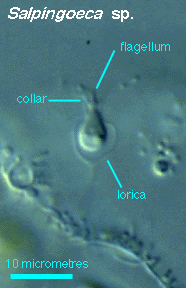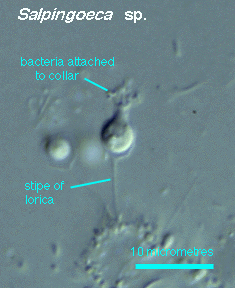Salpingoeca
Salpingoeca cells appear as sessile, thecate trophic cells and naked, free-swimming or creeping zoospores.
 |
 |
Trophic cells are roughly spherical, and reside in a theca (labelled "lorica" in the illustrations) that may or may not have a stipe. The theca, which is visible by light microscopy, is the main diagnostic character for the genus and family; in Codosigidae, no theca can be seen in the light microscope, while in Acanthoecidae the cell is surrounded by a lorica of siliceous strips ("costae"). The anterior end of the cell shows a single flagellum and a ring of tentacles. Under most light microscopes, the tentacle ring appears as a solid collar around the flagellum. In disturbed cells, both the flagellum and the collar may be shed or retracted.
Zoospores are similar to the sessile cells but are naked. During settlement, zoospores may produce fine pseudopodia at the posterior end of the cell, by which the cell slowly creeps to the position at which it will secrete its theca and become sessile.
Salpingoeca: Index | Introduction | Appearance | Ultrastructure | Reproduction and Life History | Similar genera | Classification | Taxonomy and Nomenclature | Cultures | References | Internet resources
Protist Image Data: Picture Gallery | Home Page